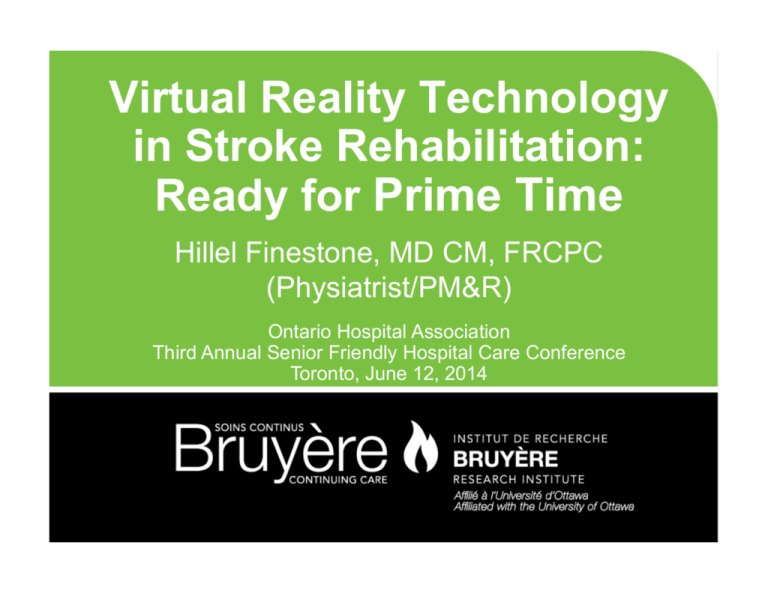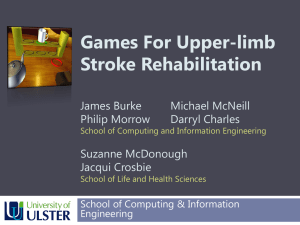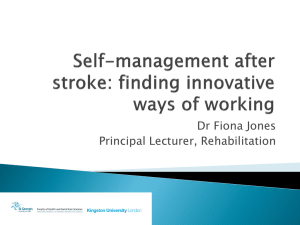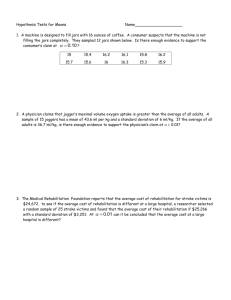Virtual Reality Technology in Stroke Rehabilitation: Ready for Prime
advertisement

Virtual Reality Technology in Stroke Rehabilitation: Ready for Prime Time Hillel Finestone, MD CM, FRCPC (Physiatrist/PM&R) Ontario Hospital Association Third Annual Senior Friendly Hospital Care Conference Toronto, June 12, 2014 Hillel Finestone • Director of Stroke Rehabilitation Research, Élisabeth Bruyère Hospital, Bruyère Continuing Care, Ottawa, Ont. • Electromyographer, The Ottawa Hospital Rehabilitation Centre • Associate Professor, Division of Physical Medicine and Rehabilitation, University of Ottawa Research Team Hillel Finestone, MD Director, Stroke Rehabilitation Research Bruyère Research Institute, Principal Investigator Heidi Sveistrup, PhD School of Rehabilitation Sciences Bruyère Research Institute, Co‐investigator Martin Bilodeau, PhD Director, School of Rehabilitation Sciences Bruyère Research Institute, Co‐investigator Research Team cont’d Anne Taillon-Hobson, MSc Bruyère Research Institute, Research Associate Dan McEwen, MSc PhD candidate, School of Rehabilitation Sciences University of Ottawa Leo Tseng, MD Physical Medicine and Rehabilitation consultant Oshawa, Ontario Objectives At the end of this presentation you will: 1. Appreciate how virtual reality (VR) exercise therapy can be applied to the rehabilitation of the older stroke patient 2. Learn about the Virtual Reality Rehabilitation After Stroke Study (VRRASS), recently completed on the Élisabeth Bruyère Hospital stroke rehabilitation inpatient unit Case Study – Mr. S. • 72-year-old man with hypertension and type 2 diabetes • On stroke rehabilitation service with right middle cerebral artery territory stroke • Poorly aware of his deficits, which include mild left hemiparesis, visual field deficit and slight left hemineglect • Attending physiotherapy, speech and language pathology (mild dysarthria), occupational therapy, nursing and social work services Case Study – Mr. S. cont’d • His family notes that “he isn’t busy. He’s used to having an active lifestyle including biking, hiking and gardening.” • “He’s watching too much TV. Is there anything else he can do to help him recover while he’s in the hospital?” …Virtual reality? In a therapeutic day: • > 50% of time spent in bed • 13% in therapeutic activities • 28% sitting out of bed • > 60% alone (Stroke 2004) • This profile does not meet the level of activity and environmental stimulation that are required for neurological recovery Introduction • Balance and independent walking are impaired after a stroke and improve after retraining (Barclay-Goddard et al. 2004; Patel et al. 2000; EBRSR – EvidenceBased Review of Stroke Rehabilitation, www.ebrsr.com, 2007) • VR exercises have been shown to improve balance in adults with TBI and adolescents with cerebral palsy (Thornton et al. 2005; Brien & Sveistrup 2011) What Is Virtual Reality? “A simulation of a real world environment that is generated through computer software and is experienced by the user through a human– machine interface” (Holden 2005) Our Study – VRRASS Virtual Reality Rehabilitation After Stroke Study New Publication Virtual Reality Exercise Improves Mobility After Stroke An Inpatient Randomized Controlled Trial Daniel McEwen, MSc; Anne Taillon-Hobson, PT, MSc; Martin Bilodeau, PT, PhD; Heidi Sveistrup, PhD; Hillel Finestone, MD, FRCPC Stroke 2014;45:1853-1855 Clinical Trial Registration—URL: http://www.ANZCTR.org.au/. Unique identifier: ACTRN12613000710729. Funding: Heart & Stroke Foundation of Canada – Canadian Partnership for Stroke Recovery; Tony Hakim Innovative Stroke Research Award; Generous donation from Elizabeth and Tony Graham Why VRRASS? • Limited research on VR for balance and gait improvements in stroke survivors • Studies to date focused on outpatient populations and chronic stroke • Cochrane,Laver et al. and Deutsch (2012) -Most studies thus far have been pilot or case studies, need to be more vigorous, controlled Questions/Objectives 1. Does VR, as an adjunct treatment, improve balance and function in the inpatient stroke rehabilitation population? 2. Are VR exercises safe and feasible to implement in an inpatient rehabilitation environment? 3. Are older stroke patients satisfied with VR exercise programs? Methods • Randomized blinded controlled trial • Ėlisabeth Bruyère Hospital inpatient stroke rehabilitation unit over 3 years Treatment Group Control Group • n = 30 • Conventional therapy + VR exercise while standing • n = 29 • Conventional therapy + exposure to VR exercise while sitting; no challenge to balance Intervention • 10–12 sessions of VR exercises with IREX (Interactive Rehabilitation Exercise) system over 3 weeks under supervision of experienced research assistant • Each session lasted ~30 minutes (~ 20 minutes of active exercise): two sets of five games with brief rest in-between sets • Outcomes assessed before (pre), immediately after (post) and 1 month after training IREX VR System • Green screen, video camera, monitor, software • Five virtual activities: soccer goaltending, snowboarding, stacking boxes, touching balls and juggling • Activities require lateral movements, shifting base of support and reaching • Participants observed closely for fatigue, potential falls, overall discomfort So, What Did We Discover? Stroke Unit Patient Demographics N = 330 176 men, 154 women Mean age 68 years (range 18–96) FIM mean total score 74 (range 23–114) FIM mean motor score 53 (range 17–90) FIM mean cognition score 21 (range 6–33) Referred to study? Yes 91 No 239 Unable to stand: ~80% Eligible Participant Demographics 91 patients referred to study Enrolled: 74 43 men, mean age 62 (range 21–86) 31 women, mean age 66 (range 18–95) FIM mean total score 90 (range 34–110) FIM mean motor score 62 (range 24–83) FIM mean cognitive score 23 (range 10–32) 59 participants 15 withdrawals Noncompliant, fatigue, unrelated seizure, technical problem etc. Refusals/unsuitable: 17 Hates computers 2 Too anxious to learn 2 Not interested 10 Severe aphasia 3 Continue with routine care and therapies Outcomes • Average FIM scores on admission were significantly higher for study participants than for nonparticipants (84.2 ± 15.0 vs. 71.8 ± 16.6) (p < 0.001) • Both groups improved significantly on all outcome measures • Both groups met minimal clinically important difference values at post for TUG and TMWT Outcomes cont’d • Treatment group had higher values than control group on TMWT, TUG and CM-Leg following training • Treatment group improved significantly more than control group on CM-Leg at post (p = 0.04) and 1 month (p = 0.02) (Fisher’s exact test) Effect size (diamonds) (and 95% confidence intervals) for difference in improvement at post and 1 month. For TMWT, effect size to right of zero line indicates improvement in treatment group; for TUG, effect size to left of zero line indicates improvement in treatment group. Conclusions • VR exercise intervention for inpatient stroke rehabilitation was safe and feasible • Stroke rehabilitation inpatients who received VR exercise training showed statistically and clinically greater improvements than control group on CM-Leg • Next step: non-ambulatory participants – sitting in wheelchair, commencing July 2014 (Heart & Stroke Foundation of Canada) Questions for Hospital Administrators • Can VR become an integral component of inpatient stroke rehabilitation, with directed programs for specific neurological impairments? E.g.: PT: “My client is having trouble trusting the limits of his balance because of his fear of falling. Could VR help this?” OT: “My client is having trouble with ADL involving dual-tasks and decision-making. Could VR help with this?” Recipe for Integrating VR into Hospital Practice Therapist motivated to learn and change… + Appropriate problem list + treatment goals + Equipment proximity, user-friendly, technical assistance, regular upgrades + Presence of opinion leader or “super-user” the staff can go to = Feasible to integrate this modality into practice (Thornton M, Boudrias Y, Millar S, Sveistrup H, Use of a computerized exercise program in a rehabilitation facility: a pilot feasibility study, manuscript in preparation) Therapist Learning Requirements • A phased approach to learning: hands-on instruction with the hardware and software to become proficient in VR system operation, followed by computer-based learning modules (Levac et al, Promoting motor learning in stroke rehabilitation: the reality of virtual reality use, manuscript in preparation) • Trained assistants to supervise program planned out by physiotherapist and occupational therapist • Evidence that integrating the technology with their current practice works. Therapists aren't looking for “toys.” Vision for VR Implementation Inpatient virtual reality Home-based and/or community virtual reality Outpatient virtual reality Hope For Mr. S. • Mr. S. participated in VR exercise sessions (snowboarding, soccer goaltending, hanggliding) during his free time in the afternoons and evenings and on weekends • The VR exercise made a difference for him • What do you do in your hospital and how easy is it to implement new technology into current treatment programs? Questions? Thank you! Virtual Reality Technology in Stroke Rehabilitation: Ready for Prime Time Hillel Finestone, MD CM, FRCPC (Physiatrist/PM&R) Ontario Hospital Association Third Annual Senior Friendly Hospital Care Conference Toronto, June 12, 2014 Outcome Measures • Berg Balance Scale (and, if ≥ 48, Community • • • • Balance and Mobility Test) Chedoke-McMaster Stroke Assessment, leg domain (CM-Leg) 2-Minute Walk Test (TMWT) Timed Up & Go Test (TUG) Number of saves on goaltending






